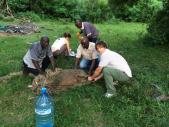Virus Hunting in Uganda
Getting to grips with African Swine Fever virus
 Dr Charles Masembe, a veterinarian, molecular epidemiologist and Associate Professor at the College of Natural Sciences, Makerere University in Uganda is collaborating with colleagues at the CVR to study the transmission dynamics of Africa swine fever virus (ASFV) in Uganda. Charles is a Wellcome Trust Fellow in Public Health and Tropical Medicine.
Dr Charles Masembe, a veterinarian, molecular epidemiologist and Associate Professor at the College of Natural Sciences, Makerere University in Uganda is collaborating with colleagues at the CVR to study the transmission dynamics of Africa swine fever virus (ASFV) in Uganda. Charles is a Wellcome Trust Fellow in Public Health and Tropical Medicine.
African swine fever (ASF) is a highly contagious haemorrhagic disease transmitted by soft bodied ticks to domestic pigs, European wild boar and American wild pigs. This devastating disease is endemic in Uganda and outbreaks can kill 90-100% of affected herds, it is a serious threat to the thriving pig production industry in Uganda.
Charles is investigating the distribution patterns of ASF, and undertaking full genome sequencing of ASFV from clinical samples to shed light on the characteristics that influence the maintenance and transmission of African swine fever at the livestock-wildlife interface in Uganda. The results of this work will directly inform the development of effective control strategies for this disease, thus contributing to the development and sustainability of the pig industry in Uganda and the livelihoods of pig farmers.
Virus hunting
 Infectious diseases (usually associated with febrile illness) are a leading cause of death in adults and children in sub-Saharan Africa and have the potential for rapid spread to other countries. Several emerging viral infections were first identified in Uganda (including West Nile virus, Bwamba fever, Semliki Forest, Kadam, O’nyong'nyong and Zika viruses) and others including Ebola virus and Marburg have recently caused epidemics in the region.
Infectious diseases (usually associated with febrile illness) are a leading cause of death in adults and children in sub-Saharan Africa and have the potential for rapid spread to other countries. Several emerging viral infections were first identified in Uganda (including West Nile virus, Bwamba fever, Semliki Forest, Kadam, O’nyong'nyong and Zika viruses) and others including Ebola virus and Marburg have recently caused epidemics in the region.
Working with our colleagues at the Uganda Virus Research Institute, Dr Emma Thomson is leading a study using next generation sequencing to detect emerging and novel viruses in samples collected from patients with febrile illness, for whom the cause of their illness has not yet been established.
This is the first application of this technology in this region which is now possible as a result of recent technological advances in genomic sequencing and the development of robust sequencing and bioinformatics pipelines at the CVR.

